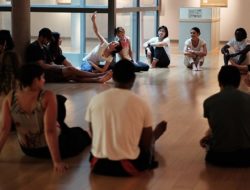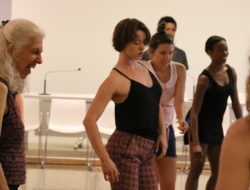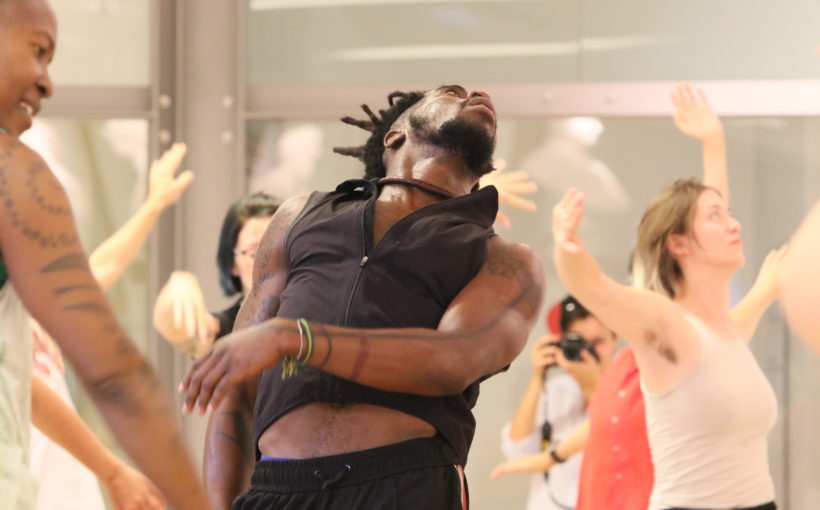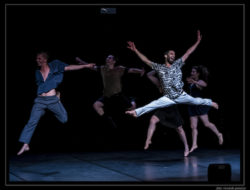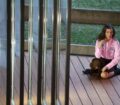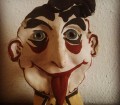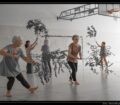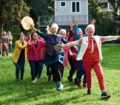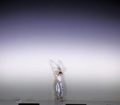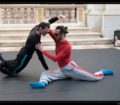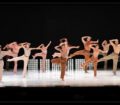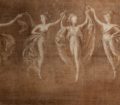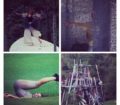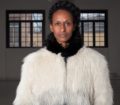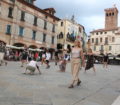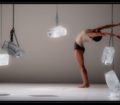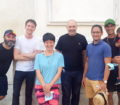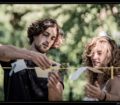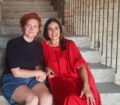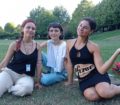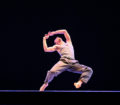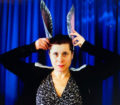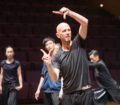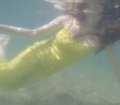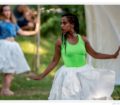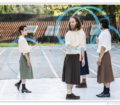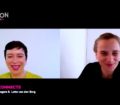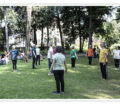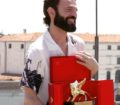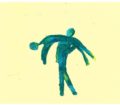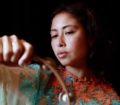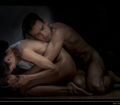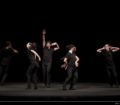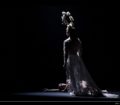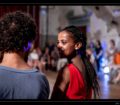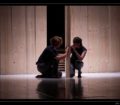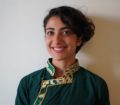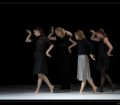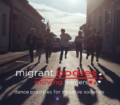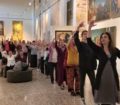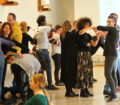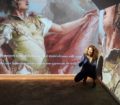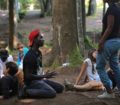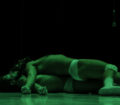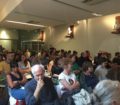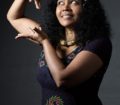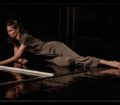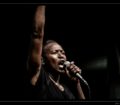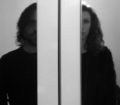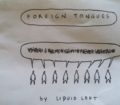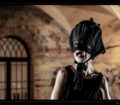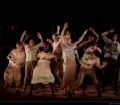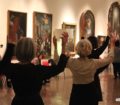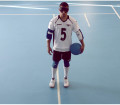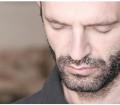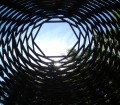ENGLISH VERSION FOLLOWS BELOW
Inizia oggi una nuova edizione di Bmotion Danza con un’atmosfera che è stata già riscaldata, e a volte anche surriscaldata, da un anomalo convegno di tre giorni in cui è parso chiaro che in questa edizione più che di danza si parlerà di corpi: corpi migranti, corpi politici, corpi attivisti, corpi impauriti, corpi culturali, corpi custodi, corpi combattenti, corpi stanchi, corpi economici, corpi condivisi, corpi ricettivi, corpi esibiti, corpi dissonanti, corpi trasmittenti,corpi radicati, corpi spirituali, corpi collettivi, corpi agitatori, corpi dissenzienti, corpi solitari, corpi silenti, corpi risvegliati, corpi responsabili, corpi co-responsabili, corpi archivi personali.
L’ho chiamato anomalo questo convegno pre-festival per la modalità in cui si è svolto. Ci si aspettava di rimanere seduti come al solito di fronte a dei relatori, e invece no. Durante la prima ora e mezza, a tutti i partecipanti – che erano parecchi, di diversa età e di tante lingue diverse, divisi in gruppi e suddivisi in stanze e piani diverse del Museo Civico di Bassano – è stato chiesto di partecipare a pratiche di danza tenute da alcuni degli artisti che durante il Festival presenteranno i propri lavori. Erano dei movimenti semplici quelli richiesti, almeno nel mio gruppo, come camminare, provare a sentire la gravità, occupare latitudini e longitudini diverse nello spazio, stabilire un contatto con gli altri attraverso lo sguardo, ascoltare e seguire il movimento del corpo del proprio compagno senza dimenticarsi del proprio, stabilire un contatto reciproco con le mani. Insomma ci è stato chiesto di tornare a recuperare e condividere quei movimenti e quelle gestualità basiche che appartengono a qualsiasi corpo, danzante e non. “Go back to the basic” ci ha detto Melanie Demers: è importante per il danzatore tornare alle basi, a quei movimenti matrice da cui poi scaturisce tutto il resto, e questo vuol dire anche togliere, eliminare il superfluo, accorgersi nuovamente delle tante altre possibilità che il corpo ci dà di comunicare, di sentirci. In quel momento, per me che non sono una danzatrice, e come me molti altri in quella stanza, questa pratica, solo in apparenza molto semplice, ha assunto un significato allargato molto forte, oserei dire politico. Dico solo in apparenza molto semplice, perché sono tante le sensazioni che ha sollevato, anche scomode e poco piacevoli, e le attenzioni che ha indirizzato. Cercare un movimento comune con un altro corpo, senza prevalere, accelerare, anticipare, o viceversa, cercare un contatto fisico, rimanere negli occhi dell’altro, nel suo ritmo, richiede fiducia, ascolto, disponibilità, anche a gestire sensazioni, pregiudizi, timidezze, paure.
Potevo fare il giro del mondo più volte rivolgendo lo sguardo a destra e a sinistra, eppure l’imbarazzo, la distanza, anche il timore di dovere comunicare con persone sconosciute, in un lingua, che sì può fare da ponte, ma che non è la mia, si sono attenuate. Vedevo i sorrisi, i dubbi, le intuizioni, la consapevolezza, vedevo i nostri corpi muoversi e interagire come espressione di un dato che è esperienziale, biologico, biografico, che porta con sé tutto quell’accumulo di sistemi simbolici e culturali, ed è lo strumento con cui ognuno rappresenta se stesso, la sua identità, la sua storia, i suoi desideri, la sua forma nel mondo.
Oggi, quindi, partiamo da qui, rendendovi partecipi attraverso contributi diversi di questa esperienza pre-festival che ha stimolato tante domande e discussioni. Nel darvi appuntamento a tra poco con il primo contributo della giornata di Lara Crippa, vi ripropongo le domande da cui è scaturito tutto: “Cos’è un archivio personale? Dove conserviamo la nostra storia?”
by Rita Borga
credits: photo by Roberto Cinconze
————————
Editorial: At Bmotion dance we are all on the same boat
Today a new edition of Bmotion Dance begins with an atmosphere that has already been warmed up, and at times even overheated, by an anomalous three-day-long convention which made very clear that, in this edition, we’ll be talking more about bodies rather than dance: migrant bodies, political bodies, activist bodies, scared bodies, cultural bodies, custodian bodies, fighting bodies, tired bodies, economic bodies, shared bodies, receptive bodies, exhibited bodies, conflicting bodies, transmitting bodies, rooted bodies, spiritual bodies, collective bodies, agitating bodies, dissenting bodies, lonely bodies, silent bodies, awakened bodies, responsible bodies, co-responsible bodies, personal-archive bodies.
I described this convention as anomalous due to the way in which it took place. We expected to stay sat down as usual in front of the speakers, but it wasn’t the case. During the first hour and a half, all the participants – who were numerous, of different age groups and of various languages, split into groups and divided into different rooms and floors of the Museo Civico in Bassano – were asked to take part in dance practices held by some of the artists who will present their works during the Festival. The movements that were requested were simple, at least in my group, such as walking, trying to feel the gravity, occupying different latitudes and longitudes in the space, establishing a reciprocal contact using the hands. To put it shortly, we were asked to retrieve and share those movements and those gestures that belong to any body, whether it’s a dancing body or not. “Go back to the basics”, we were told by Melanie Demers: it’s important for the dancer to go back to the basics, to those original movements from which everything then develops, and this also means removing, eliminating anything superfluous, becoming aware again of all the many other possibilities that our body gives us to communicate, to feel each other. In that moment, to me, as a non-dancer, and like many others in that room, this practice, only seemingly simple, took on a very strong, broad meaning, I dare say even political. I say only seemingly simple because it triggered many feelings, even uncomfortable and unpleasant ones, and because of the awareness it directed. Looking for a common movement with another body, without prevailing, accelerating, anticipating, or vice versa, looking for physical contact, staying in the other person’s eyes, in his/her rhythm demands trust, the ability to listen, availability, and even to manage sensations, prejudices, shyness, fears.
I could have travelled the world several times looking left and right, but the embarrassment, the distance, and even the fear of having to communicate with strangers, in a language, that can indeed be a bridge, but that isn’t my own, died down. I saw smiles, doubts, intuitions, awareness, I saw our bodies moving and interacting like the expression of a piece of information that is existential, biological, biographical, that carries with it all the accumulation of symbolical and cultural systems, and it’s the tool with which we all represent ourselves, our identity, our story, our wishes, our shape in the world.
So today, we start from here, sharing this pre-festival experience with you, which triggered many questions and discussions, through different contributions. Hoping to see you later at the first contribution of the day by Lara Crippa, I ask you the same questions from which everything began:
“What is a personal archive? Where do we preserve our story?”
translated by Elena Baggio
credit: photo by Roberto Cinconze
Tags: #personalarchive, archivio personale, Bmotion danza, editoriale, Operaestate Festival Veneto

